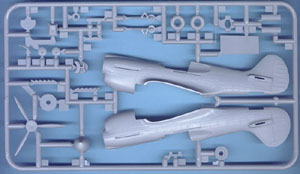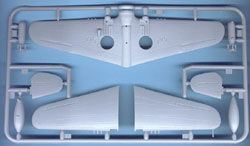Smer's 1/72 P-40K / Kittyhawk III
By Chris Banyai-Riepl
 |

 |
 The Kit
The Kit Once the fuselage is finished up, it's time to turn to the wings. These match up to the drawings in Detail & Scale pretty closely, so you don't have to worry about changing shape with these parts. The lower wing is molded as one piece, and incorporates the cowl flaps. These are somewhat soft in molding, though, and it might be better to shave those off and replace them with plastic card. The instructions also point out that you have to remove a bump from the lower left wing. The fit to the fuselage looks good, although there may be a bit of work needed on the trailing edge of the wing where it meets the fuselage centerline. Speaking of trailing edges, the wings could probably use a bit of thinning. The stabilizers are one piece and could use a bit of sanding on the trailing edge to round them off, but for the most part they're spot on.
Once the fuselage is finished up, it's time to turn to the wings. These match up to the drawings in Detail & Scale pretty closely, so you don't have to worry about changing shape with these parts. The lower wing is molded as one piece, and incorporates the cowl flaps. These are somewhat soft in molding, though, and it might be better to shave those off and replace them with plastic card. The instructions also point out that you have to remove a bump from the lower left wing. The fit to the fuselage looks good, although there may be a bit of work needed on the trailing edge of the wing where it meets the fuselage centerline. Speaking of trailing edges, the wings could probably use a bit of thinning. The stabilizers are one piece and could use a bit of sanding on the trailing edge to round them off, but for the most part they're spot on. The decals are a nice point in this kit, printed by Propagteam and up to their usual standards. You get three choices in the kit, one British, one US and one Soviet. The British one is the boxtop example, finished in dark earth and middlestone over azure blue and sporting a sharkmouth. The US example also harkens from the desert, being finished in desert pink over azure blue. This one features artwork on the chin of a scorpion on a cloud. The Soviet example has an interesting camouflage of dark green and dark earth over sky, with 17 kill markings on the left side. The registration is spot on and the colors are excellent.
The decals are a nice point in this kit, printed by Propagteam and up to their usual standards. You get three choices in the kit, one British, one US and one Soviet. The British one is the boxtop example, finished in dark earth and middlestone over azure blue and sporting a sharkmouth. The US example also harkens from the desert, being finished in desert pink over azure blue. This one features artwork on the chin of a scorpion on a cloud. The Soviet example has an interesting camouflage of dark green and dark earth over sky, with 17 kill markings on the left side. The registration is spot on and the colors are excellent.